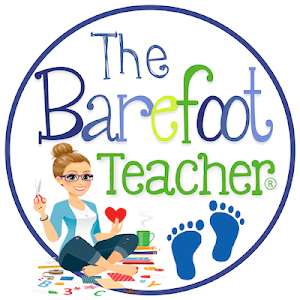Are you a Kindergarten teacher struggling to effectively implement the Next Generation Science Standards? Don't worry, I've got your back! Join me in this series on how to successfully implement the NGSS in your classroom.
(Not familiar with the NGSS standards? Then take some time to read "Getting to Know the Next Generation Science Standards: Kindergarten" first.)
Today I'm going to introduce you to my Science Interactive Notebooks...a simple way to practically and effectively engage your students.
Now before I begin any of the NGSS standards in my class, I always go over The Five Senses first.
So that's what we are going to focus on today: The Five Senses: Interactive Notebook.
Each science interactive notebook set, including this one, comes with a set of corresponding classroom posters to hang around your room. Here are the posters that come with the Force & Motion set:

I start the book off with a fun cute & paste activity that reinforces what body parts are involved with the Five Senses.

You can give your girls the girl page, and your boys the boy page...or you may even have some students that want to do both! (Or maybe you have your fast finishers do both.)



As the kids eat the popcorn, have them think about how each of their senses are being used. Did they hear the popcorn being made? Can they smell the butter? What does it look like? How does it feel in their hands or mouth? Then have them go back to the page and write their observations under each flap.
So that's what we are going to focus on today: The Five Senses: Interactive Notebook.
Each science interactive notebook set, including this one, comes with a set of corresponding classroom posters to hang around your room. Here are the posters that come with the Force & Motion set:

I start the book off with a fun cute & paste activity that reinforces what body parts are involved with the Five Senses.

You can give your girls the girl page, and your boys the boy page...or you may even have some students that want to do both! (Or maybe you have your fast finishers do both.)
The next page is a vocabulary reinforcer:
This Pocket full of Vocab matches the poster set (shown above). Have students pull the cards out of the pocket and review the meanings of the terms. They can quiz themselves, quiz a neighbor, and even write short definitions on the back to help them remember. You'll see this page in each and every science interactive notebook...with the corresponding vocab terms of course.
The next five pages go with each of the five senses. Students color in the objects on the page that correspond with the sense labeled at the top.
Now, if you look closely, you'll see that the sample picture has some objects colored in that shouldn't be! (No, you can't TASTE toilet paper or worms...and you can't FEEL shooting stars!) If you have students that color in objects that do not relate to the sense, simply have a quick discussion about why it doesn't belong, and then place a big "X" over the object.
What can you do with your Five Senses? Use a pencil and paper clip to turn this activity into a Spin 'n Tell.

Whatever picture it lands on, that's what you describe...For example, my spinner lands on the nose picture. That means I describe things I can smell with my nose: I can smell my mom's apple pie when I come home from school. I can smell the flowers outside of the house...and so on.
On this page, students color the pictures on the flaps. Then the lift up each flap and circle which of the Five Senses are involved with interacting with that object.

So for the rose picture, I would circle sight (I can see it.), smell (I can smell it.), and touch (because I can feel it.) We might even go more in depth and talk about how the rose would FEEL different ways depending on which part of it we touch...sharp if I touch the thorn, or soft if I touch the petal. I can't eat it or hear it, so I don't circle those options for this picture.
The next activity is one that you will also find with each and every science interactive notebook theme of mine. I've noticed that kids LOVE to prove how smart they are. So I created this page that not only reinforces your class discussions on Force & Motion, but also give the kids a chance to feel smart, review their friends, and practice what they've learned.
Students simply pull out one of the many questions and either answer the questions or do what it says.
The last activity is a Popcorn Investigation! Take your students down to the teachers lounge for a special trip to help you microwave some popcorn! Then bring it back to the classroom and divvy it out.

As the kids eat the popcorn, have them think about how each of their senses are being used. Did they hear the popcorn being made? Can they smell the butter? What does it look like? How does it feel in their hands or mouth? Then have them go back to the page and write their observations under each flap.
And there you have it!
Does that all make "sense"?
(Ok, ok, lame joke, I know!)
(Ok, ok, lame joke, I know!)
-Til next time



































































